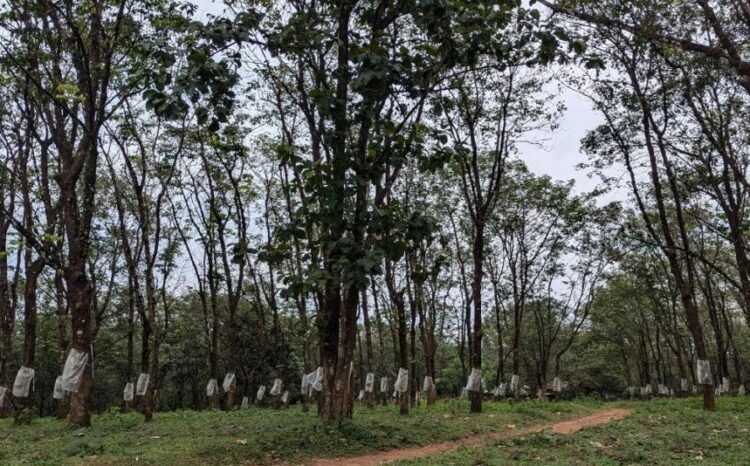Over 3.4 lakh trees are set to be cut down, and 352 families will require relocation to make way for the construction of the Sabarimala Greenfield Airport.
NEW DELHI: The construction of the Sabarimala Greenfield Airport in Erumely South and Manimala villages has raised significant concerns regarding environmental and agricultural sustainability. The project requires extensive land acquisition, leading to the large-scale removal of trees and disruption of the existing ecosystem.
A total of approximately 1039.876 hectares is required for the project, spanning Blocks 19 and 21 of Manimala Village and Blocks 22 and 23 of Erumeli South Village in Kanjirappally Taluk, Kottayam District.
The estimated cost for constructing the airport is approximately Rs. 3450 crore, as per the study conducted by Louis Berger Consultants.
Over 3.4 lakh trees are set to be cut down, and 352 families will require relocation to make way for the construction of the Sabarimala Greenfield Airport, according to the Social Impact Assessment (SIA) report.
Deforestation and Agricultural Loss
The airport construction will necessitate the removal of a significant number of trees and cash crops, affecting the region’s biodiversity and agricultural economy. The affected flora includes:
- Rubber trees: 333,262
- Teak trees: 2,492
- Wild Jack (Anjili): 2,247
- Banana plants: 1,326
- Jackfruit trees: 1,131
- Arecanut trees: 2,449
- Coconut trees: 1,017
- Coffee plants: 5,250
- Black Pepper vines: 1,906
- Tapioca plants: 2,476
- Mahogany trees: 828
- Pineapple cultivation: 90 hectares
The deforestation will lead to a loss of natural shade and habitat, impacting the region’s microclimate. The felling of over 3 lakh rubber trees alone signifies a massive carbon sink depletion, affecting local air quality and contributing to climate change.
Impact on Water Resources and Irrigation
The project is expected to disturb natural water flows, affecting irrigation channels that local farmers rely on. Water tables may decline due to extensive excavation, leading to long-term effects on groundwater recharge. The loss of natural vegetation will accelerate soil erosion and water runoff, reducing the region’s ability to retain rainwater.
Threat to Indigenous Flora and Fauna
The proposed land is home to a variety of native species, including the Cheruvally cow, a distinctive cattle breed. The relocation of estate workers threatens the traditional breeding and conservation of this native species. The loss of natural habitats may also impact birds, insects, and other small wildlife in the area.
Livelihood Disruptions for Farmers and Workers
Many local farmers and estate workers depend on cash crops like rubber, coffee, coconut, and spices for their livelihood. The project’s large-scale land acquisition will force them to relocate, leading to a decline in agricultural output. Additionally, workers engaged in the plantation sector will lose employment, creating economic instability in the region.
Recommendations for Sustainable Development
To mitigate environmental damage and agricultural loss, the following measures are recommended:
- Reforestation and Greenbelt Development – A structured replantation program should be implemented to compensate for lost trees.
- Water Conservation Strategies – Constructing artificial lakes and rainwater harvesting systems to maintain water tables.
- Livelihood Rehabilitation for Farmers – Providing financial assistance and alternative employment opportunities for affected farmers and estate workers.
- Biodiversity Protection – Implementing conservation programs for native species such as the Cheruvally cow and promoting eco-friendly development practices.
- Sustainable Land Use Planning – Developing a strategy to ensure minimal ecological impact while maximizing infrastructure benefits.
Conclusion
While the Sabarimala Greenfield Airport is a crucial infrastructure project, it must be executed with environmental sustainability in mind. Addressing deforestation, agricultural displacement, and water resource management will be essential in ensuring that economic progress does not come at the cost of ecological degradation. The government must balance development with environmental responsibility, ensuring a greener and more sustainable future for the region.
Sabarimala Greenfield Airport: An Overview
Notified by: Kottayam District Collector
Requisition Authority: Kerala State Industrial Development Corporation Ltd (KSIDC), Thiruvananthapuram
Social Impact Assessment Study Unit: Bharata Mata School of Social Work, Bharata Mata College, Thrikkakara, Kochi- 21
The Sabarimala Greenfield Airport project is a strategic initiative conceptualized to cater to both short-term and long-term transportation needs in alignment with local, state, and national development objectives. Given the increasing number of travelers, tourists, and overseas Malayalis, the establishment of an international airport at Erumeli has been deemed appropriate, considering the developmental potential of the Pathanamthitta, Kottayam, and Idukki districts.
Initially conceptualized within the Cheruvally Estate, the project encountered spatial limitations, necessitating additional land acquisition outside the estate to accommodate a longer runway essential for international operations. As a result, a total of approximately 1039.876 hectares is required for the project, spanning Blocks 19 and 21 of Manimala Village and Blocks 22 and 23 of Erumeli South Village in Kanjirappally Taluk, Kottayam District.
The estimated cost for constructing the airport is approximately Rs. 3450 crore, as per the study conducted by Louis Berger Consultants.
Project Location and Size
The proposed site for the airport has been meticulously selected after an extensive review of multiple locations. The primary factors considered include land availability, topography, distance from key locations, accessibility, and future development potential. The final location at Cheruvally Estate was selected due to its optimal geographical characteristics and connectivity.
The project area comprises land that falls under the categories of dry land and government-owned land. It includes 2263 acres from Cheruvally Estate and 307 acres belonging to private landowners, totaling 2570 acres. The designated land acquisition blocks are:
- Blocks 22 and 23 of Erumeli South Village
- Blocks 19 and 21 of Manimala Village
Alternatives Considered
A government-appointed review committee evaluated six potential sites before finalizing Cheruvally Estate. The shortlisted sites included:
- Harrison Malayalam Plantation (Cheruvally Estate) – Spanning 2,263.18 acres, this location in Kanjirappally Taluk was chosen for its accessibility and flat terrain.
- Travancore Rubbers Cliptham (Propos Estate) – Spanning 824.48 acres, this site was close to Erumeli but had significant forest coverage.
- Tropical Plantation (Vellanadi Estate) – Covering 749.10 acres, this site was deemed less suitable due to its hilly terrain and lack of direct road connectivity.
- Laha Estate – Although 2,466.11 acres were available, the site was surrounded by forests on three sides, limiting development potential.
- Kalleli Estate – Spanning 2,629.50 acres, the site was hilly with limited transport facilities, making it unsuitable.
- Kumbazha Estate – Covering 2,569.89 acres, this location lacked direct road access and posed development constraints.
Following an extensive evaluation based on land availability, accessibility, and development potential, Cheruvally Estate was chosen as the most viable site.
Land Acquisition and Social Impact
The project necessitates the acquisition of 1039.876 hectares, impacting 245 landowners and resulting in the displacement of 352 families. Among them, 114 families reside outside the estate, while 238 families live and work within Cheruvally Estate. The direct social impacts include:
- Loss of habitable houses and income derived from plantations.
- Impact on 391 individuals dependent on agricultural activities.
- Displacement of 328 elderly individuals, including widows.
- Relocation of seven places of worship, including St. Thomas Ecumenical Church, Hidayathul Islam Juma Masjid, and St. Gregorious Kurishu Pally.
- Relocation of Noel Memorial LP School, a ration shop, and a dispensary.
- Loss of employment for permanent workers within Cheruvally Estate.
Additionally, five commercial establishments and key infrastructure such as compound walls, borewells, and rainwater harvesting systems will be impacted.
Environmental and Agricultural Impact
The airport construction will necessitate the removal of a significant number of trees and cash crops. The affected flora includes:
- Rubber trees: 333,262
- Teak trees: 2,492
- Wild Jack (Anjili): 2,247
- Banana plants: 1,326
- Jackfruit trees: 1,131
- Arecanut trees: 2,449
- Coconut trees: 1,017
- Coffee plants: 5,250
- Black Pepper vines: 1,906
- Tapioca plants: 2,476
- Mahogany trees: 828
- Pineapple cultivation: 90 hectares
The Cheruvally cow, a native breed found in the project area, is also at risk due to relocation of estate workers, potentially affecting its conservation. Additionally, water flows and irrigation channels will be impacted.
Legal and Administrative Framework
Under Section 4(1) of the Right to Fair Compensation and Transparency in Land Acquisition, Rehabilitation and Resettlement Act (30 of the Central Act, 2013), the government is mandated to conduct a Social Impact Assessment (SIA). Bharata Mata School of Social Work, Bharata Mata College, Thrikkakara, has been designated as the SIA unit for the project.
The Kerala Gazette Revenue B, Volume 13, G.O.(P) No. 204/2024/RD, dated 10.09.2024, has officially notified the land acquisition.
Conclusion and Recommendations
While the Sabarimala Greenfield Airport is an essential infrastructure project with immense economic and developmental potential, the land acquisition process must be managed with sensitivity to mitigate adverse social and environmental impacts. Recommendations include:
- Fair compensation and rehabilitation for affected families.
- Alternative employment opportunities for displaced estate workers.
- Sustainable environmental measures, including reforestation and preservation of native flora and fauna.
- Infrastructure support such as new schools, religious institutions, and roads to compensate for lost facilities.
The successful implementation of the project depends on balanced planning that ensures both economic growth and social welfare, reinforcing Kerala’s position as a key aviation hub while maintaining its commitment to sustainable and inclusive development.
(India CSR)







